If you happen to find yourslef in Limassol, Cyprus, this week, do check out Working towards our own obsolescence, an exhibition I curated with and for the NeMe Arts Centre. The show features the work of artists who are critically investigating the ways digital technology is affecting labour conditions. The artworks explore new forms of exploitation, precariousness and dependency but also tactics to fight back and regain some agency/humanity. Working towards our own obsolescence is thus both tragic and uplifting. It also has its moments of humour. Thanks in part to Pippin Barr…
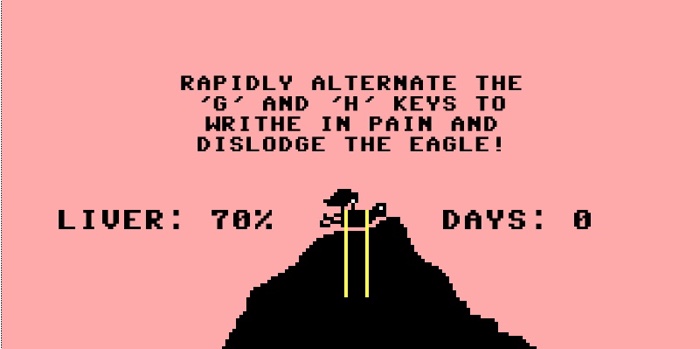
Pippin Barr, Let’s Play: Ancient Greek Punishment: Prometheus vs. Eagle
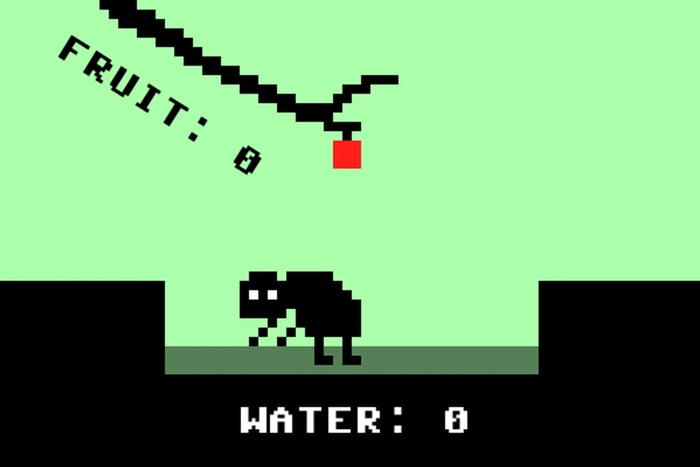
Pippin Barr, Let’s Play: Ancient Greek Punishment: Tantalus vs. Apple
Pippin Barr is the maker of curious, absurd and witty video games. Some of them invite you to be brutally tortured by the revengeful Gods of Ancient Greek mythology, to play fanciful versions of chess, contend with the tricky Trolley Problem or revisit iconic works of contemporary art. Barr is an assistant professor in the Department of Design and Computation Arts at Concordia University, the associate director of the Technoculture, Art, and Games (TAG) Lab and a visiting lecturer in the Institute of Digital Games at the University of Malta. He holds a Ph.D. in Computer Science from Victoria University of Wellington, New Zealand.
Pippin Barr, The Artist Is Present 2 (Trailer), 2020
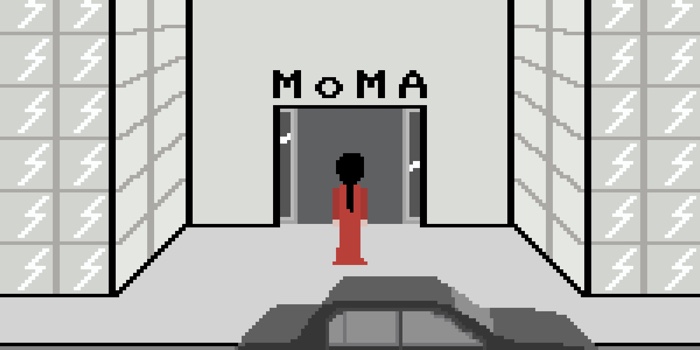
Pippin Barr, The Artist Is Present 2, 2020
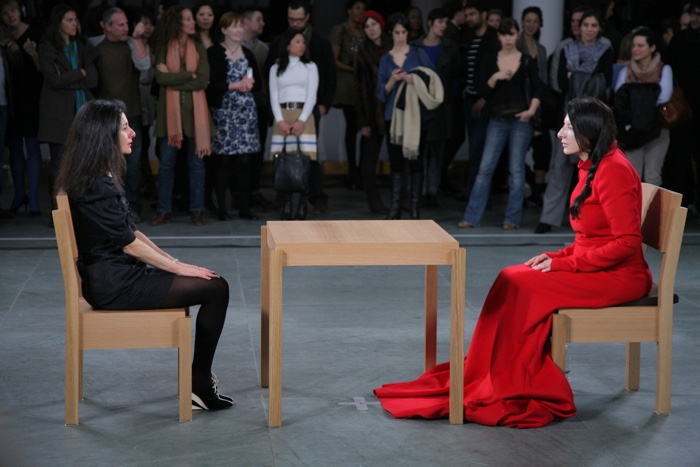
Marina Abramović, The Artist is Present, at MOMA, 2009
In 2011, Barr made headlines in art magazines with The Artist is Present, a digital version of Marina Abramović’s famous performance of the same name. People would queue at MOMA to sit at a table across from the artist who would then look into their eyes in silence. The performance lasted 8 hours a day, for nearly three months. In Barr’s excruciating version of the performance, players had to stand in line and wait for hours in order to sit in front of Abramović’s avatar. To ensure that players queued mindfully (instead of checking their emails, tweeting or watching videos on another tab), they’d sometimes be prompted to move their avatar forward. If they missed the cue, the players lost their place in line.
This wasn’t a game you could play mindlessly. By forcing you to focus on one single activity (ensuring that your avatar didn’t lose its space in the queue), the game made you painfully aware of what commitment and time mean. Time is actually something you are very conscious of when playing some of Barr’s other works. You can literally mirror the fate of the Greek characters by playing the Let’s Play: Ancient Greek Punishment series forever. Like Sisyphus, for example, you could roll a huge boulder endlessly up a hill only for it to roll down every time you’ve almost reached the top. And then you have to do it again and again. There’s something equally maniacal, frustrating and repetitive in It is as if you were doing work, the game selected for the exhibition at NeMe. The browser-based game caricaturizes office work and seems to encapsulate all the futility of what anthropologist David Graeber called Bullshit Jobs. The piece invites the player to “recapture an appearance of usefulness through traditional human-computer interaction”.

Pippin Barr, It is as if you were doing work, 2017. Exhibition view at NeMe. Photo by Nicos Avraamides

Pippin Barr, It is as if you were doing work, 2017
I interviewed most of the protagonists of the NeMe exhibition and couldn’t resist transcribing my video exchange with Pippin Barr. We talked about mischievous games, their place in contemporary art and so much more:
Hi Pippin! There are at least two reasons why I thought It is as if you were doing work would play an interesting role in the exhibition at NeMe. One of them is that there is an increasing use of gamification in the workplace and in particular in the gig economy sector. Was this gamification of work something that you had in mind when you developed the game and do you see maybe some parallels between games and work?
That’s an interesting question. While creating It is as if you were doing work, I wasn’t explicitly looking to talk about gamification or to critique gamification. However, I agree that gamification or at least tropes from video game design have melded fairly naturally with capitalism and the ways that work is increasingly experienced, especially as work is more and more performed on computers. Even though I wouldn’t say that the game is about gamification, it felt extremely natural to include quantification as a core element of any kind of futuristic vision of work or kind of work adjacent ideas. Maybe it also works the other way: games often feel like work, the idea being that they’re a kind of pleasurable work.
Saving the universe in a game may not look like regular work but it’s broken down into tasks and you have people asking you to do things for them on a deadline (like save the universe). With gamification, companies see in games a way to make what is effectively labour feel good to players and they’re folding point systems and bonuses into work.
Something I admire really in your work is that your first concern is not about the player laughing and having a particularly pleasant experience. For example, I love It is as if you were doing work as much as I hate it because it’s an irritating game to play. I had to stop before finishing the session because I was getting a bit angry at the constant pop-up and at the requests to write yet another email. Can you say something about the playability of the game?
When I think of a game, I don’t set out to create a frustrating or challenging experience. I think of an idea first. Maybe something that amuses me in the shower or while I’m walking down the street… anything that makes me laugh for a moment. For example, a game where literally all that you do is interact with standard user interface elements. The very first genesis of the idea was that it would be a game with a slider that you move up and down to different settings and it would just tell you to set the slider to nine and you would do it and then you would get points or something and then that would be it, that would be the game. You get a standard user interface interaction and I ask you to play it. It is like the minimal sense of what a game can be. I pursued that idea and ultimately, it turned into this larger experience of It is as if you were doing work but there’s never a point where I was trying to think about how extra-annoying I can be. The reason why the games can be frustrating or feel weird is that I’m interested in inviting the player to think about what you’re doing while you’re doing it which can often be alienating when you’re used to immersive experiences.
In a sense, if you have an idea and then you just pursue it as a kind of ground truth, chances are that it is not going to fit in with ideas of playability and entertainment and so forth because it requires a huge amount of very sophisticated work to create a fun and engaging game. It also requires fitting in with traditions and definitions for players and player culture of how those things work. I don’t feel like you can easily do both at the same time. It can be very difficult to have a game that is fun and tragic for example or that is fun but also deep and intellectual. These things can be jarring together or they can simply not support each other. It’s always been my practice to communicate an idea and use the game form to express it regardless of whether it ends up being fun and regardless of whether people on reddit hate me or not.
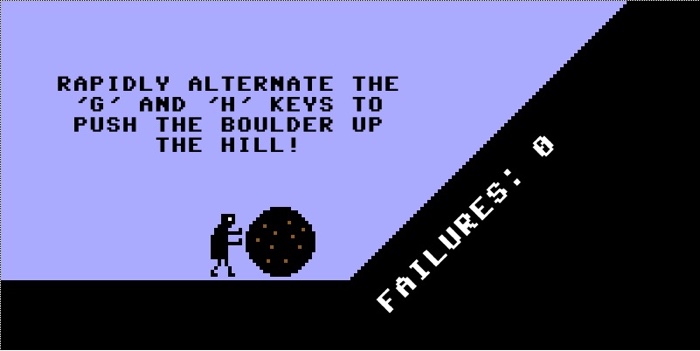
Pippin Barr, Let’s Play: Ancient Greek Punishment: Sisyphus vs. Boulder

Pippin Barr, Let’s Play: Ancient Greek Punishment: Sisyphus vs. Boulder
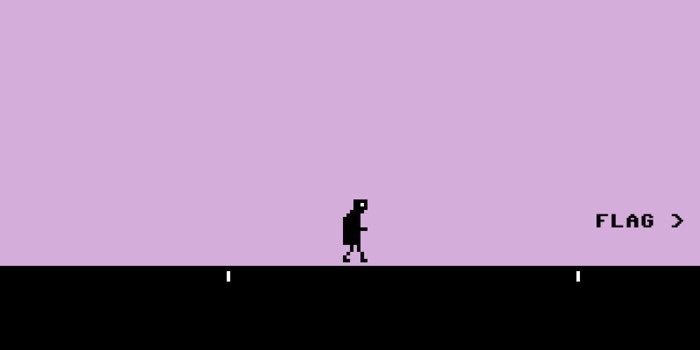
Pippin Barr, Let’s Play: Ancient Greek Punishment: Zeno vs. Flag
I’m also curious about your interest in Greek mythology. You dedicated a whole series to Ancient Greek punishments…
I made the first Greek punishment game around 2011 so it’s been a decade (which is a bit horrifying in terms of age!). That’s a very long time to still be interested in something and I think that really speaks to the power and the fundamental nature of those myths and the way we relate to them. Their simplicity makes these myths applicable to many contexts but they’re just such powerful distillations of an amazing story. Sisyphus, for example, is about the sweat and the rock and all kinds of emotional things. But then you read Camus and realise that Sisyphus is a powerful metaphor that can be applied to so many contexts.
The game started, as it often happens, with a few doodles in my notebook. I just thought of a game where you push the boulder up the hill and it rolls back down. It just amuses me to think that it is like a game because you’re exerting effort towards a goal, it’s challenging, you’re hitting two keys very quickly to exert effort, etc. But then you can literally never succeed so is it really a game? That’s why it’s funny and maybe this is one where I was trying to be annoying towards the players, but I also like the idea that players are in on the joke, that they would also realise that it’s eternal and impossible. When I made that first version of the game which includes other punishment myths like Tantalus or Prometheus, etc. I slipped Zeno in there and although that’s not actually an Ancient Greek punishment story, he just deserves to be punished.
I started also thinking about how the game form or the computational simulation of those experiences is the perfect way of telling the story of Sisyphus. Usually, when you tell that story it’s not infinite, it’s still a bounded narrative with a beginning and an end.
A video game, however, can simulate eternity. It is also putting you in the position of being subjected to infinite punishment. Of course, it is infinite within some boundaries because your computer is not going to last for an infinite amount of time, it will eventually rust or decay or something else might happen to it but at least the potential for infinity is in the computational nature of the piece. I found that very interesting.
That metaphorical nature of the myth also plays into experiences that we have with computers. There’s often the sense that they’re meant to be kind of straightforward and obvious and yet we keep failing to succeed with them or we keep being asked to do the same thing over and over and over and over again. The strength of those metaphors and the clarity of those stories made me want to keep making them again and again as a way of exploring different kinds of expressive capacities of games. So, I became interested in different ways of basically making the same game but making it again in a different form and seeing what kinds of nuances emerge. For example, I made a typing version which is like Mavis Beacon Teaches Typing. You’re typing and the faster you type, the faster you push the boulder up the hill which added different kinds of layers to the experience. It allowed me to introduce a bit more narrative to it for example. I also made a user interface version to connect back to It is as if you were doing work where it’s about presenting user interfaces as this kind of frustrating infinite struggle that we go about: we will continuously interact with computers and their interfaces until our death beds. Presumably, we will still be scrolling Instagram or something as we die. It’s interesting how those myths fit on top of different kinds of presentations and they kind of stay fresh to me.
The other thing that happened by the way during the time that I made a lot of those games is we’d just had our son Felix and it was a way for me to still make work but in a really, really circumscribed kind of way where I didn’t have to come up with new ideas particularly. I just had to express the same idea in different forms. I found that extremely helpful in terms of feeling like I was still making and thinking about things while also not sleeping very much and being obsessed with a small child.

Pippin Barr, Zorba, 2011
I read in an interview that your parents are art collectors and that you grew up in the contemporary art world. Not so long ago, there were heated debates in contemporary art institutions as to whether video games were a form of art and whether or not they deserved to be shown as part of the programme. Do you feel that the kind of works that experimental game developers and artists like you are doing has finally been embraced by the art world or would you say that you’re still very much at the margin?
That’s an interesting question. I feel like there’s a real division between, on the one hand, the kind of blockbuster shows like the one at the Smithsonian or the big one at the V&A (my work was part of it which was neat for me) which are at least part of the public consciousness and targeted at a broad general audience and, on the other hand, smaller galleries -often European ones- that have been showing more experimental video game works for quite a long time. So, it doesn’t feel as uncommon or unsupported, especially when it comes to smaller-scale institutions.
I also think that there’s a distinction to be made there between trying to have this popular cultural image of what art is and whether video games are part of it or not. That’s been a very fraught debate which I think sensible people ignore because it’s a bit silly. I don’t feel marginalised at all. On the other hand, I don’t feel that, generally speaking, the big shows are particularly interested in the elements of video games and art production that I am exploring.
There’s still a tendency to be excited about how beautiful the graphics are, for example. Or to listen to the music and say “Can you believe that a video game has such wonderful music blah blah blah,” and less about work that thinks about the formal structures of games or the expressive capacity of games in weirder ways.
I’m just personally drawn more to conceptual art and formal approaches to art and that’s a personal thing but for me, it’s less interesting to be excited about amazing graphics. It’s like being excited about photography because it’s so realistic or something like that. At the same time, I think all the curators I’ve ever been in contact with totally get it and have been getting it for a long time. Personally, I’m not sure it matters too much whether or not the big institutions understand what I’m trying to do, in part because digital games are still not an amazing fit for the bricks and mortar buildings where you go to see the pantheon of art. Besides, I think people are still trying to figure out how to install them: “Do they need extra context?”, “Should it just be a laptop on a plinth?”, etc. I’ve always thought about my work really as being played by people in their office or in their bedroom or sitting on a sofa or whatever. The white cube context has never really played a big part in what I think is interesting about what I’m doing actually.
I actually discovered your work a few years ago in the exhibition GAMERZ. Your game was shown in a comfortable setting where the visitor could sit in an armchair and everything was very cozy and nothing made you feel as if you were in exhibition space…
I’m glad that they were able to do that. I think that people often get seduced by the white cube aesthetics and want it to kind of look like it’s a normal art show and then you have like a plinth with a laptop on it and visitors are standing awkwardly in front of the screen playing a game when in fact that’s not how games are played. You lose some of the relationships between a player and a game when you start taking away the coziness of the situation that’s normally the case.

Pippin Barr, It is as if you were doing work, 2017. Exhibition view at NeMe. Photo by Nicos Avraamides

Pippin Barr, It is as if you were doing work, 2017
We just talked about the big contemporary art world and I’m going to go in the opposite direction: I was wondering if this kind of strange experimental games with unusual rules and playability (like the ones you create) can become massive successes? Or do you absolutely need the fantastic graphics and perfect playability to become mainstream?
I think that the general answer is probably “no” in the sense that I don’t think there’s any game that I’ve made where, if I charged for it, I would make millions of dollars. It’s just not where that work is going, so I think in terms of having mass appeal which is what you obviously need generally speaking in order to make a lot of money, if that’s the kind of success we’re talking about.
Indie games are also becoming this massive thing with some titles that become surprising successes. One game that i would call experimental and that met a broad success is Papers, Please. It’s an independent title and it’s pretty surprising that people were so excited about it. Like It is as if you were doing work, it’s a representation of labor. You’re asked to do what seems to be an extremely boring job which is stamping people’s passports. It’s not relying on an exciting narrative with spies coming through, bombings and shooting people at the border. That’s not what the job of a border officer is really like. Lucas Pope is an incredible game designer, he found that balancing act between an unlikely premise and a set of mechanics which are in some sense boring and a narrative framing around that and beautiful tiny elements of design that drew people in. Many of the more experimental games are pulling conventional game design into more interesting areas while acknowledging some of the conventions of design.
Undertale is another interesting example. It looked like it should have been a niche cute little role-playing game that inverts a lot of ideas about what it means to fight with somebody. And yet, it became a huge success and one of the weirder ones. Maybe “huge” success is the wrong word for it but Cart Life. I don’t know if you’ve heard of Cart Life…
No
It’s a few years old now but it won the grand prize at the Independent Games Festival and was acknowledged as a great work by the larger community. I think it did okay commercially as well. It’s a very stripped-back, quite depressing story about hardship and running a food cart while also having to go home to look after your daughter. It is really digging into a kind of realism in play that you don’t normally see because games are so often about skating over the surface of all of the little pieces that make life what it is. Developers think that we want to escape but then games like Papers Please or Cart Life are pulling it back towards well… life itself. If somebody pitched the idea of a passport officer stamping people’s passports, you wouldn’t say that it is going to be a hit and it probably wouldn’t get the green light at a Hollywood studio, but it turns out that it is possible to marry that idea with game mechanics in a way that interests people.
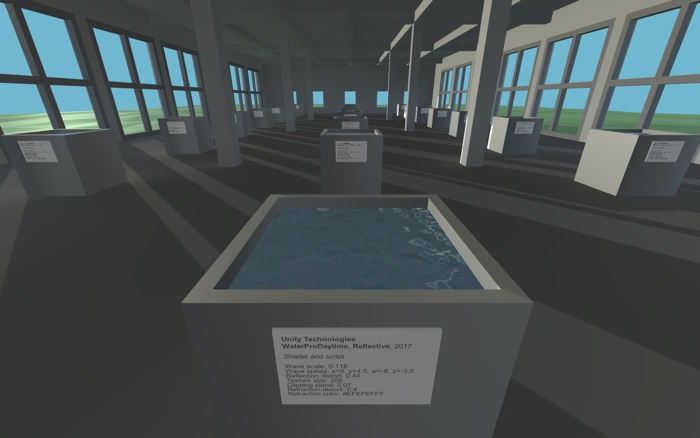
Pippin Barr, v r 3, 2017
Do you have any upcoming projects, research or events that you are working on at the moment?
I’m quite excited actually about two things. I’m equally intimidated by both of them which, I’m hoping, is a good sign.
The first one is a sequel to a series called the v r series. v r 3 was a museum of water where you would see different kinds of water that you could have in a specific game engine. It’s based on Donald Judd’s 100 untitled works in mill aluminum in Marfa. I’m continuing the idea behind that work with a game called v r $4.99. It is going to be a virtual exhibition of things that cost $4.99 in the unity asset store. Unity is a game engine that has a store where you can buy things: if you need a horse for your game, you buy a horse and if you need a desert, then you buy a desert. They all cost different prices but one of the major price points is 4.99. I’m buying different things and I’m installing them for people to look at and think about why this fish cost $4.99 and why this giant building costs $4.99, etc. It’s an exploration of the capitalism of the platform but I’m also interested in inviting comparison. I provide a kind of framework for the player to do all of the thinking about these things.
The other project I’m working on is a little bit less clear. I want to make a game that makes you watch a movie by mistake. I want to have a kind of a framing narrative that seems very exciting where you’re probably a contract killer or some kind of conventional character. I’m scared to do it because I don’t know how to do that kind of thing, but the idea is that you’re a killer and you’re trying to kill a person that is in a film theater and you’re sitting in the back row waiting to kill them but while you’re waiting, there’s a movie on and you naturally end up watching the movie as an assassin waiting to kill somebody. In the end, you never get to kill them. You just watch the movie and then that’s kind of finishes. You’ve watched a movie instead of killing somebody. I haven’t figured out how to do it yet but that’s what I want: accidentally watching a movie in a video game.
Thanks Pippin!
Pippin Barr’s work is part of the exhibition Working towards our own obsolescence, on view at NeMe in Limassol, Cyprus, until 30 July 2021.







